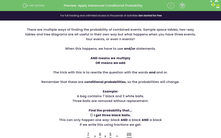There are multiple ways of finding the probability of combined events. Sample space tables, two-way tables and tree diagrams are all useful in their own way but what happens when you have three events, four events, or even n events?
When this happens, we have to use and/or statements.
AND means we multiply
OR means we add
The trick with this is to rewrite the question with the words and and or.
Remember that these are conditional probabilities, so the probabilities will change.
Example:
A bag contains 7 black and 3 white balls.
Three balls are removed without replacement.
Find the probability that...
1) I get three black balls.
This can only happen one way: black AND a black AND a black
If we write this using fractions we get:
|
x |
|
x |
|
= |
|
This fraction will cancel down to 7/24
2) I get 2 black and 1 white ball.
There are actually three different ways this can happen:
black AND a black AND a white
OR
black AND a white AND a black
OR
white AND a black AND a black
The trick here is to know that each one of these probabilities will actually be the same (try it, you'll see it's true) so we only have to find one.
Let's find black AND a black AND a white
|
x |
|
x |
|
= |
|
We can now say that the probability of getting two blacks and a white is:
|
+ |
|
+ |
|
= |
|
This will cancel down to 21/40
3) The probability of getting at least one white.
For this, you could work out the probability of each one that satisfies this and add them all together - there's 7 ways this could happen.
or
You could use the fact that P(at least 1) = 1 - P(none)
So P(at least 1 white) = 1 - P(no whites)
P(at least 1 white) = 1 - P(3 blacks)
We worked out earlier that P(3 blacks) = 7/24
So we can say that the probability of getting at least one white = 1 - 7/24 = 17/24
Let's move on to try some questions now.







